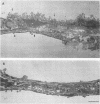Abstract
Mortality during the first several days of pneumococcal pneumonia has not decreased appreciably over the past 30 years, despite the widespread use of antibiotics. Disruption of the alveolar epithelial barrier is likely an initial step in the pathogenesis of pneumococcal pneumonia. We report that soluble factors from Streptococcus pneumoniae can directly injure isolated rat alveolar epithelial cells. Using biochemical and immunological techniques, we identified pneumolysin as a major soluble S. pneumoniae toxin for alveolar epithelial cells. Alveolar epithelial cells at 24 or 72 h after isolation were equally sensitive to injury by purified pneumolysin. Purified pneumolysin substantially increased alveolar permeability in an isolated perfused rat lung model. Electron microscopy revealed that instilled pneumolysin caused widespread lung injury, primarily to type I alveolar epithelial cells. Pneumolysin toxicity to alveolar epithelial cells may be important in the pathogenesis of acute lung injury during pneumococcal pneumonia and may facilitate pneumococcal bacteremia.
Full text
PDF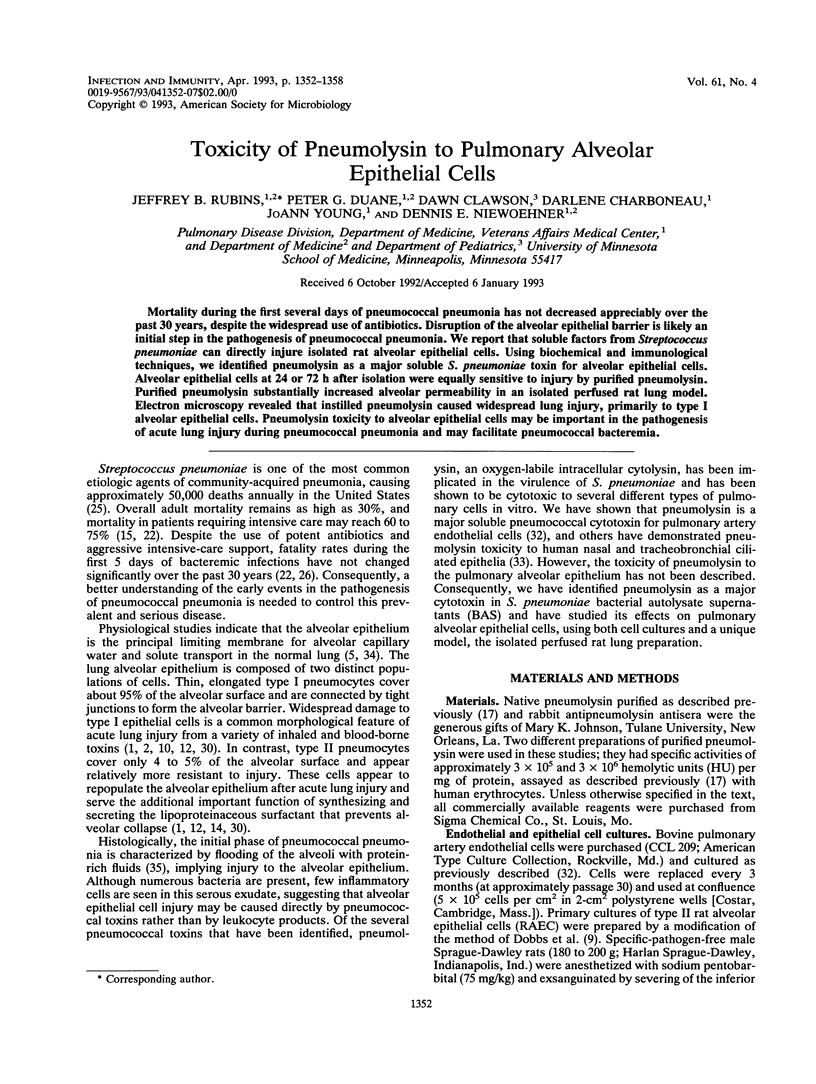
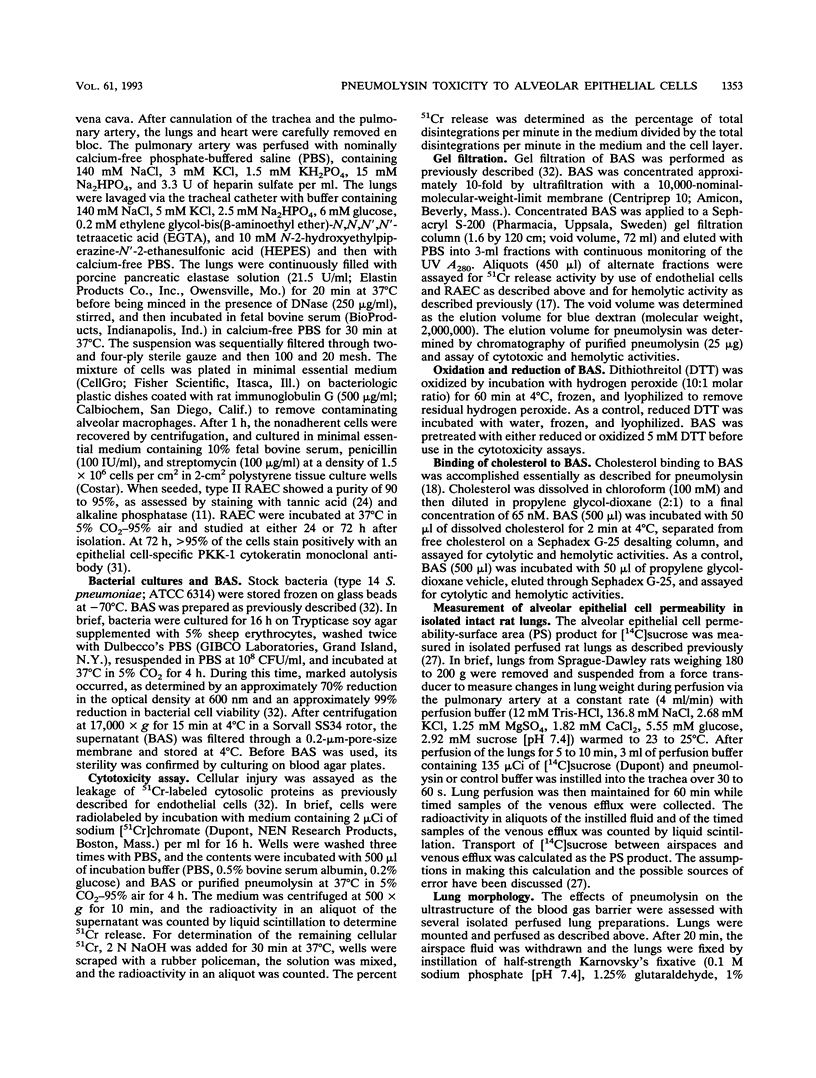
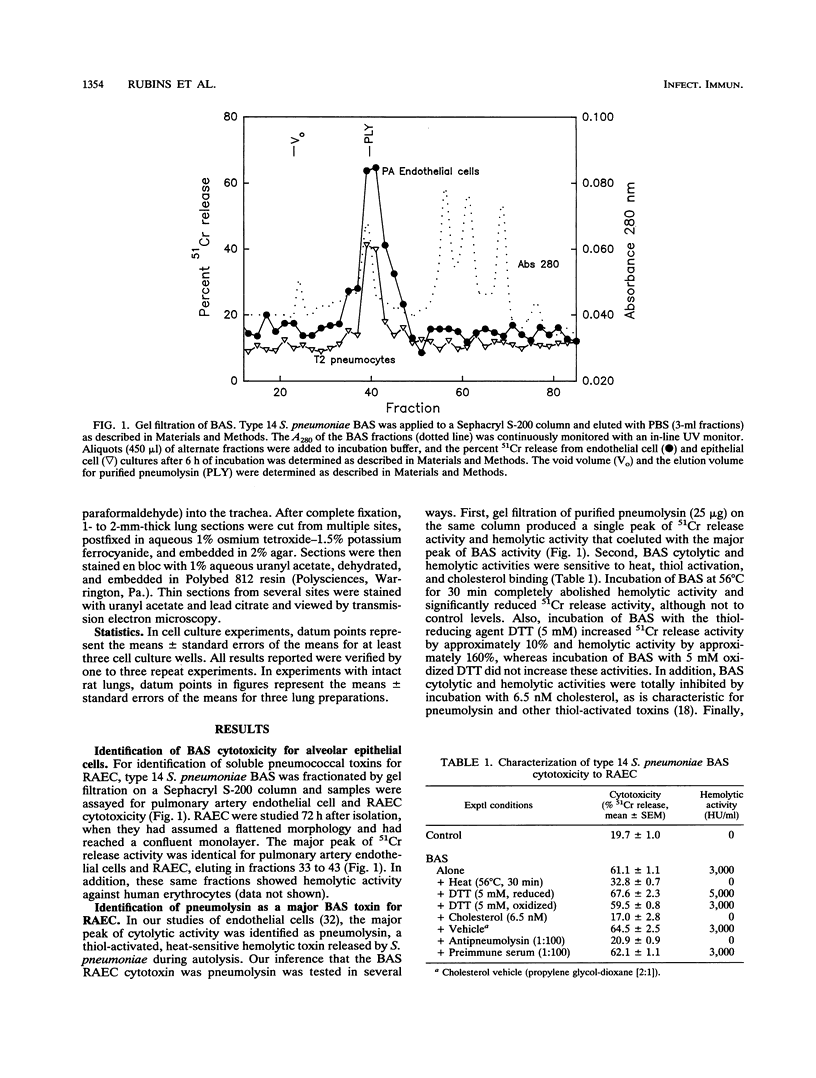
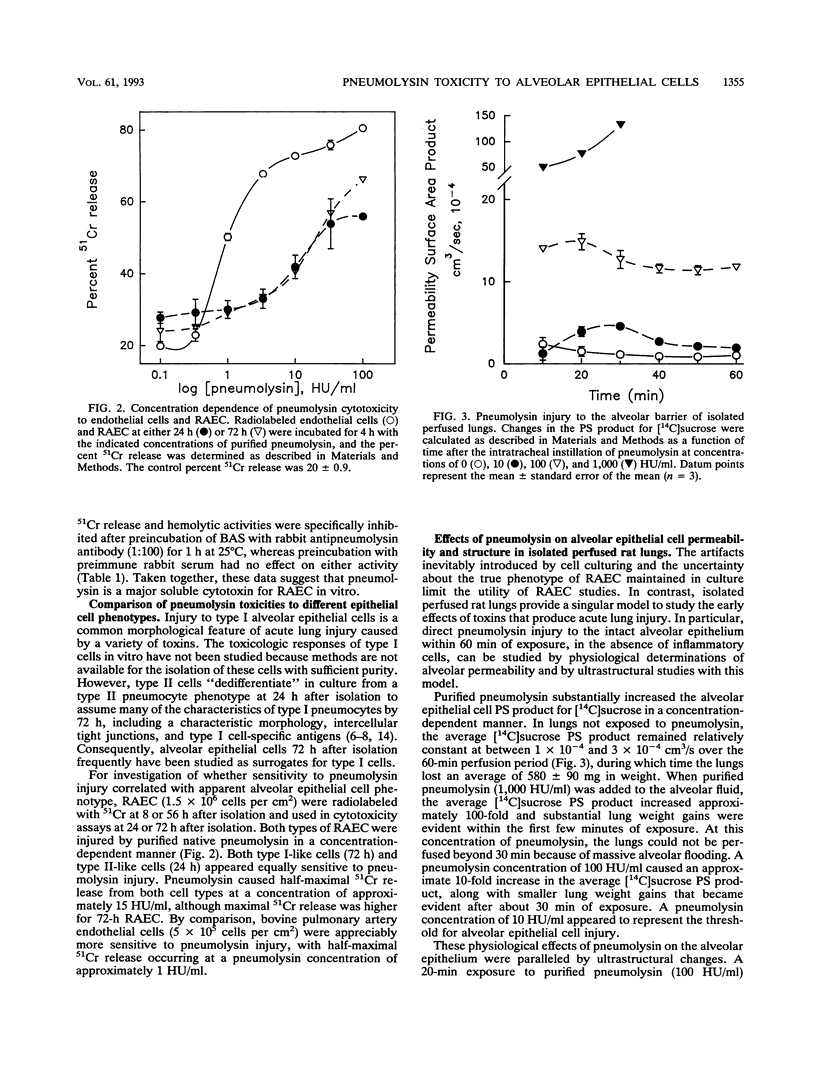
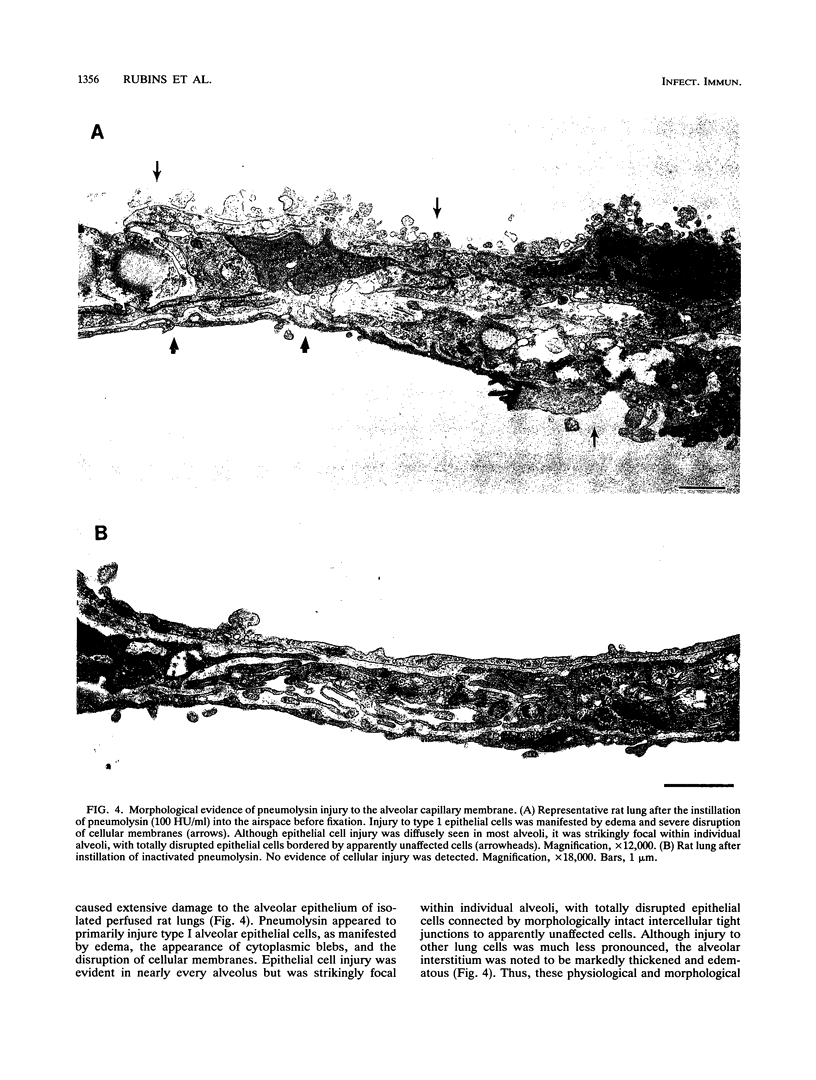
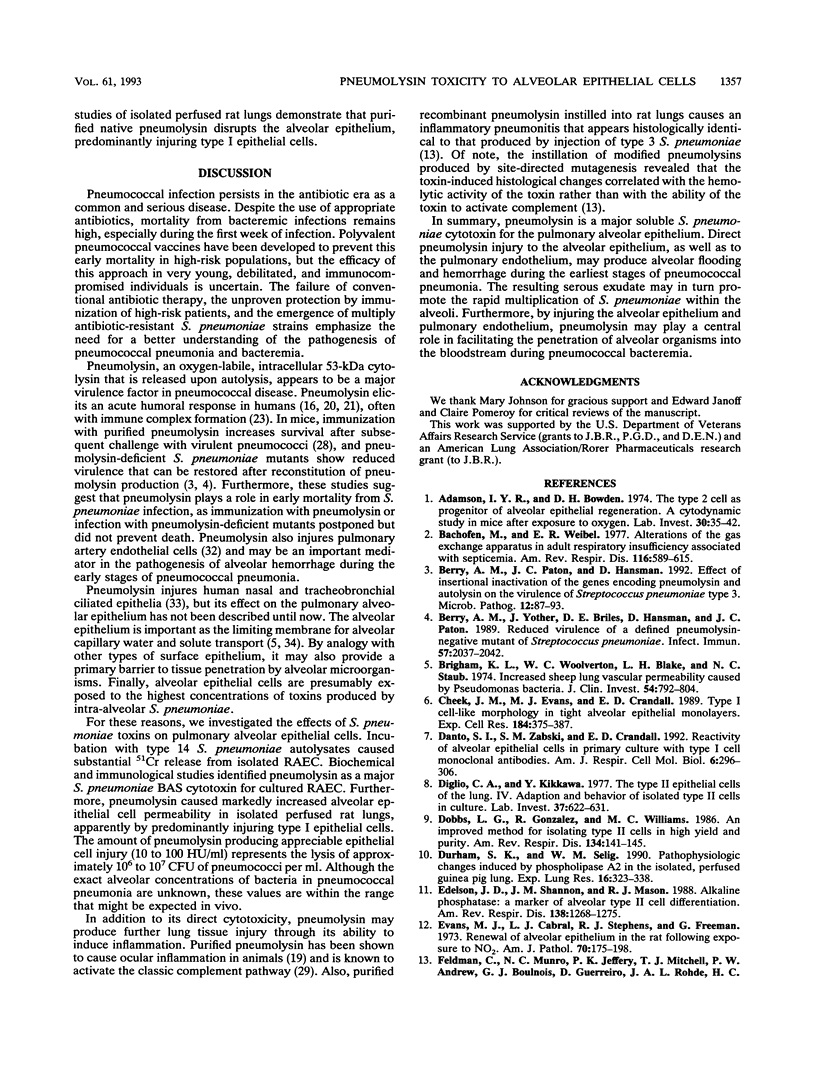
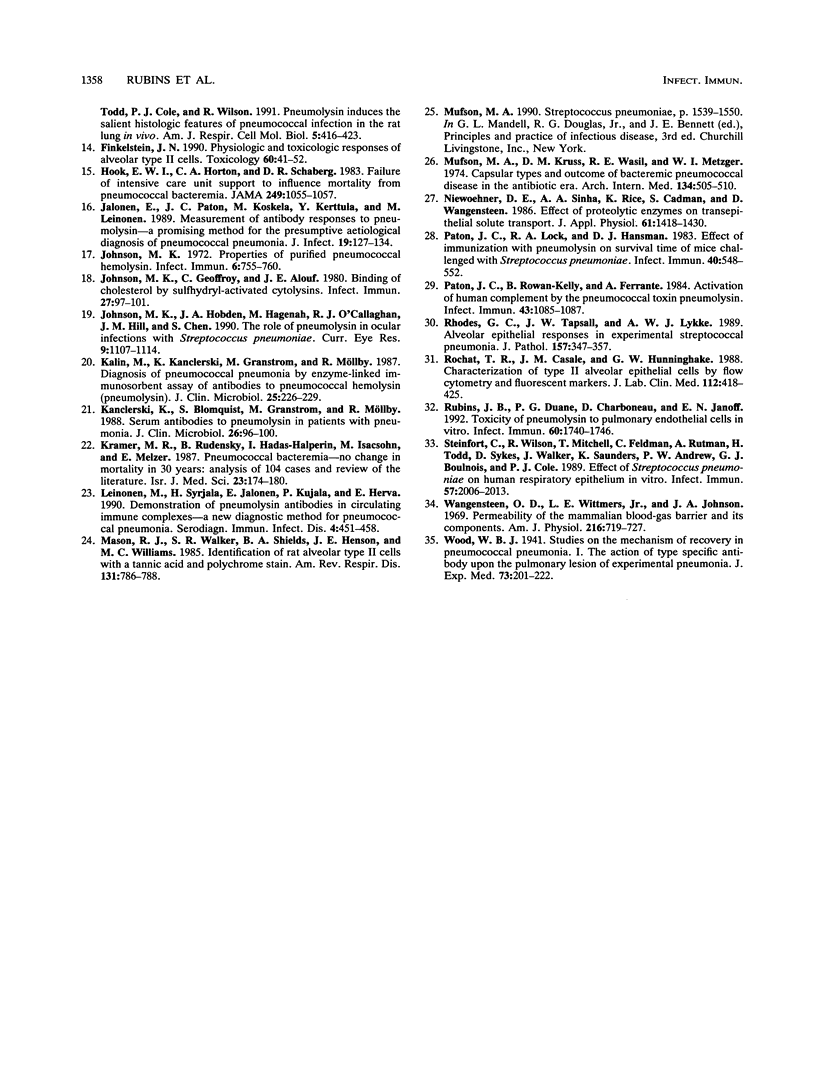
Images in this article
Selected References
These references are in PubMed. This may not be the complete list of references from this article.
- Adamson I. Y., Bowden D. H. The type 2 cell as progenitor of alveolar epithelial regeneration. A cytodynamic study in mice after exposure to oxygen. Lab Invest. 1974 Jan;30(1):35–42. [PubMed] [Google Scholar]
- Bachofen M., Weibel E. R. Alterations of the gas exchange apparatus in adult respiratory insufficiency associated with septicemia. Am Rev Respir Dis. 1977 Oct;116(4):589–615. doi: 10.1164/arrd.1977.116.4.589. [DOI] [PubMed] [Google Scholar]
- Berry A. M., Paton J. C., Hansman D. Effect of insertional inactivation of the genes encoding pneumolysin and autolysin on the virulence of Streptococcus pneumoniae type 3. Microb Pathog. 1992 Feb;12(2):87–93. doi: 10.1016/0882-4010(92)90111-z. [DOI] [PubMed] [Google Scholar]
- Berry A. M., Yother J., Briles D. E., Hansman D., Paton J. C. Reduced virulence of a defined pneumolysin-negative mutant of Streptococcus pneumoniae. Infect Immun. 1989 Jul;57(7):2037–2042. doi: 10.1128/iai.57.7.2037-2042.1989. [DOI] [PMC free article] [PubMed] [Google Scholar]
- Brigham K. L., Woolverton W. C., Blake L. H., Staub N. C. Increased sheep lung vascular permeability caused by pseudomonas bacteremia. J Clin Invest. 1974 Oct;54(4):792–804. doi: 10.1172/JCI107819. [DOI] [PMC free article] [PubMed] [Google Scholar]
- Cheek J. M., Evans M. J., Crandall E. D. Type I cell-like morphology in tight alveolar epithelial monolayers. Exp Cell Res. 1989 Oct;184(2):375–387. doi: 10.1016/0014-4827(89)90337-6. [DOI] [PubMed] [Google Scholar]
- Danto S. I., Zabski S. M., Crandall E. D. Reactivity of alveolar epithelial cells in primary culture with type I cell monoclonal antibodies. Am J Respir Cell Mol Biol. 1992 Mar;6(3):296–306. doi: 10.1165/ajrcmb/6.3.296. [DOI] [PubMed] [Google Scholar]
- Diglio C. A., Kikkawa Y. The type II epithelial cells of the lung. IV. Adaption and behavior of isolated type II cells in culture. Lab Invest. 1977 Dec;37(6):622–631. [PubMed] [Google Scholar]
- Dobbs L. G., Gonzalez R., Williams M. C. An improved method for isolating type II cells in high yield and purity. Am Rev Respir Dis. 1986 Jul;134(1):141–145. doi: 10.1164/arrd.1986.134.1.141. [DOI] [PubMed] [Google Scholar]
- Durham S. K., Selig W. M. Pathophysiologic changes induced by phospholipase A2 in the isolated, perfused guinea pig lung. Exp Lung Res. 1990 Jul-Aug;16(4):323–338. doi: 10.3109/01902149009108848. [DOI] [PubMed] [Google Scholar]
- Edelson J. D., Shannon J. M., Mason R. J. Alkaline phosphatase: a marker of alveolar type II cell differentiation. Am Rev Respir Dis. 1988 Nov;138(5):1268–1275. doi: 10.1164/ajrccm/138.5.1268. [DOI] [PubMed] [Google Scholar]
- Evans M. J., Cabral L. J., Stephens R. J., Freeman G. Renewal of alveolar epithelium in the rat following exposure to NO2. Am J Pathol. 1973 Feb;70(2):175–198. [PMC free article] [PubMed] [Google Scholar]
- Feldman C., Munro N. C., Jeffery P. K., Mitchell T. J., Andrew P. W., Boulnois G. J., Guerreiro D., Rohde J. A., Todd H. C., Cole P. J. Pneumolysin induces the salient histologic features of pneumococcal infection in the rat lung in vivo. Am J Respir Cell Mol Biol. 1991 Nov;5(5):416–423. doi: 10.1165/ajrcmb/5.5.416. [DOI] [PubMed] [Google Scholar]
- Finkelstein J. N. Physiologic and toxicologic responses of alveolar type II cells. Toxicology. 1990 Jan-Feb;60(1-2):41–52. doi: 10.1016/0300-483x(90)90161-9. [DOI] [PubMed] [Google Scholar]
- Hook E. W., 3rd, Horton C. A., Schaberg D. R. Failure of intensive care unit support to influence mortality from pneumococcal bacteremia. JAMA. 1983 Feb 25;249(8):1055–1057. [PubMed] [Google Scholar]
- Jalonen E., Paton J. C., Koskela M., Kerttula Y., Leinonen M. Measurement of antibody responses to pneumolysin--a promising method for the presumptive aetiological diagnosis of pneumococcal pneumonia. J Infect. 1989 Sep;19(2):127–134. doi: 10.1016/s0163-4453(89)91864-1. [DOI] [PubMed] [Google Scholar]
- Johnson M. K., Geoffroy C., Alouf J. E. Binding of cholesterol by sulfhydryl-activated cytolysins. Infect Immun. 1980 Jan;27(1):97–101. doi: 10.1128/iai.27.1.97-101.1980. [DOI] [PMC free article] [PubMed] [Google Scholar]
- Johnson M. K., Hobden J. A., Hagenah M., O'Callaghan R. J., Hill J. M., Chen S. The role of pneumolysin in ocular infections with Streptococcus pneumoniae. Curr Eye Res. 1990 Nov;9(11):1107–1114. doi: 10.3109/02713689008997584. [DOI] [PubMed] [Google Scholar]
- Johnson M. K. Properties of purified pneumococcal hemolysin. Infect Immun. 1972 Nov;6(5):755–760. doi: 10.1128/iai.6.5.755-760.1972. [DOI] [PMC free article] [PubMed] [Google Scholar]
- Kalin M., Kanclerski K., Granström M., Möllby R. Diagnosis of pneumococcal pneumonia by enzyme-linked immunosorbent assay of antibodies to pneumococcal hemolysin (pneumolysin). J Clin Microbiol. 1987 Feb;25(2):226–229. doi: 10.1128/jcm.25.2.226-229.1987. [DOI] [PMC free article] [PubMed] [Google Scholar]
- Kanclerski K., Blomquist S., Granström M., Möllby R. Serum antibodies to pneumolysin in patients with pneumonia. J Clin Microbiol. 1988 Jan;26(1):96–100. doi: 10.1128/jcm.26.1.96-100.1988. [DOI] [PMC free article] [PubMed] [Google Scholar]
- Kramer M. R., Rudensky B., Hadas-Halperin I., Isacsohn M., Melzer E. Pneumococcal bacteremia--no change in mortality in 30 years: analysis of 104 cases and review of the literature. Isr J Med Sci. 1987 Mar;23(3):174–180. [PubMed] [Google Scholar]
- Mason R. J., Walker S. R., Shields B. A., Henson J. E., Williams M. C. Identification of rat alveolar type II epithelial cells with a tannic acid and polychrome stain. Am Rev Respir Dis. 1985 May;131(5):786–788. doi: 10.1164/arrd.1985.131.5.786. [DOI] [PubMed] [Google Scholar]
- Mufson M. A., Kruss D. M., Wasil R. E., Metzger W. I. Capsular types and outcome of bacteremic pneumococcal disease in the antibiotic era. Arch Intern Med. 1974 Sep;134(3):505–510. [PubMed] [Google Scholar]
- Niewoehner D. E., Sinha A. A., Rice K., Cadman S., Wangensteen D. Effect of proteolytic enzymes on transepithelial solute transport. J Appl Physiol (1985) 1986 Oct;61(4):1418–1430. doi: 10.1152/jappl.1986.61.4.1418. [DOI] [PubMed] [Google Scholar]
- Paton J. C., Lock R. A., Hansman D. J. Effect of immunization with pneumolysin on survival time of mice challenged with Streptococcus pneumoniae. Infect Immun. 1983 May;40(2):548–552. doi: 10.1128/iai.40.2.548-552.1983. [DOI] [PMC free article] [PubMed] [Google Scholar]
- Paton J. C., Rowan-Kelly B., Ferrante A. Activation of human complement by the pneumococcal toxin pneumolysin. Infect Immun. 1984 Mar;43(3):1085–1087. doi: 10.1128/iai.43.3.1085-1087.1984. [DOI] [PMC free article] [PubMed] [Google Scholar]
- Rhodes G. C., Tapsall J. W., Lykke A. W. Alveolar epithelial responses in experimental streptococcal pneumonia. J Pathol. 1989 Apr;157(4):347–357. doi: 10.1002/path.1711570412. [DOI] [PubMed] [Google Scholar]
- Rochat T. R., Casale J. M., Hunninghake G. W. Characterization of type II alveolar epithelial cells by flow cytometry and fluorescent markers. J Lab Clin Med. 1988 Oct;112(4):418–425. [PubMed] [Google Scholar]
- Rubins J. B., Duane P. G., Charboneau D., Janoff E. N. Toxicity of pneumolysin to pulmonary endothelial cells in vitro. Infect Immun. 1992 May;60(5):1740–1746. doi: 10.1128/iai.60.5.1740-1746.1992. [DOI] [PMC free article] [PubMed] [Google Scholar]
- Steinfort C., Wilson R., Mitchell T., Feldman C., Rutman A., Todd H., Sykes D., Walker J., Saunders K., Andrew P. W. Effect of Streptococcus pneumoniae on human respiratory epithelium in vitro. Infect Immun. 1989 Jul;57(7):2006–2013. doi: 10.1128/iai.57.7.2006-2013.1989. [DOI] [PMC free article] [PubMed] [Google Scholar]
- Wangensteen O. D., Wittmers L. E., Jr, Johnson J. A. Permeability of the mammalian blood-gas barrier and its components. Am J Physiol. 1969 Apr;216(4):719–727. doi: 10.1152/ajplegacy.1969.216.4.719. [DOI] [PubMed] [Google Scholar]



